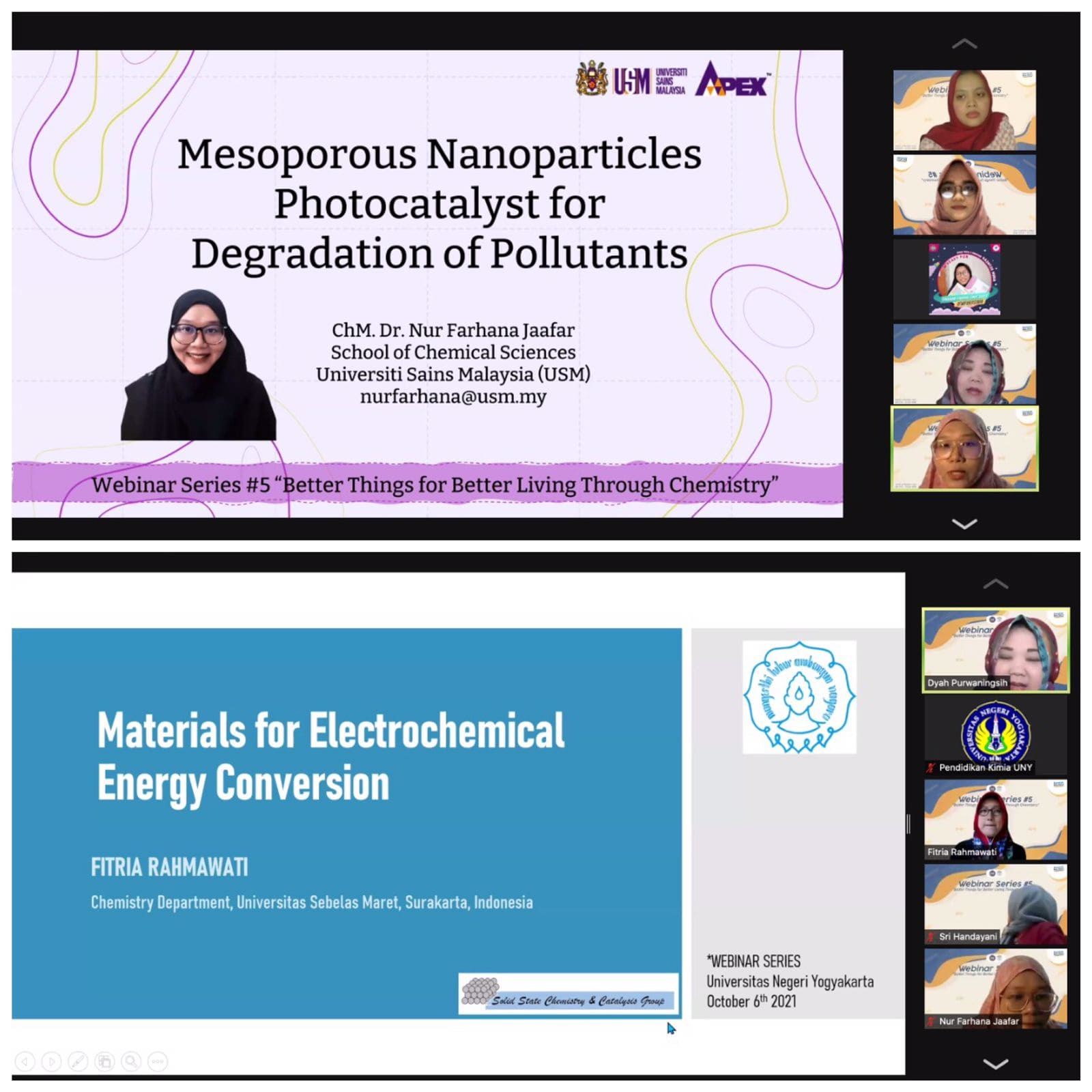You are here
Chemistry Education Department - Webinar Series #5

The Department of Chemistry Education, Faculty of Mathematics and Natural Sciences, UNY has held an online Webinar Series #5 on Saturday, October 9, 2021. This activity was attended by a number of 198 participants from among lecturers, teachers, students, etc. There were two resource persons who were invited to fill the webinar series #5, namely ChM. Dr. Nur Farhana Jaafar from the School of Chemical Sciences, Universiti Sains Malaysia (USM) and Prof. Fitria Rahmawati from Chemistry Department, Sebelas Maret University, Surakarta, Indonesia.
In his presentation, Dr. Farhana conveyed about Mesoporus Nanoparticles Photocatalyst for Degradation of Pollutants. Dr. Farhana started her presentation on photocatalytic degradation. Dr. Farhana said that the advanced oxidation process is a chemical treatment procedure to remove organic and inorganic materials in wastewater by oxidation. The oxidation mechanism depends on the production of active species such as hydroxyl radicals (•OH), while hydrogen peroxide (H2O2), ozone (O3), oxygen (O2) and air are commonly used as reagents in oxidizing pollutants. In his research, Dr. Farhana uses mesoporous materials which have unique properties of adjustable pore size and structure, large surface area and pore volume, controllable morphology and modifiable surface, high chemical and thermal stability. The main advantage of mesoporous materials in heterogeneous catalysis is the possibility of finding larger reactants and larger molecules. Another method of mesostructured silica modification is the co-condensation method (one pot synthesis). During the formation of the meso-structured silica, a modifier is added to the mixture of the structure-directing material and the silica source. Functionalization with this method will result in the projection of organic functionality into the pores. Some of the advantages of this method are that pore clogging is not a problem, and the organic units are generally more homogeneously distributed. However, some of the methodological drawbacks associated with the co-condensation method are that care must be taken not to damage the organic functionality during surfactant removal, which is why usually only extractive methods can be used, and calcination is not suitable in most of the methods.
The presentation was continued by Prof. Fitria Rahmawati. Prof. Fitria submitted a paper entitled Materials for Electrochemical Energy Conversion. His research is motivated by an increase in CO2 emissions from burning fossil fuels globally and a description of the impact of global warming. The problems that are often faced by Indonesia are often floods, droughts, increasing infectious diseases, and decreasing agricultural production. Therefore, new and renewable energy is needed as well as clean technology conversion, including through solar cells, fuel cells, sunlight, wind, sea waves, and energy storage systems. Energy conversion using electrochemical cells is a useful alternative to overcome various problems related to energy because electrochemical cells are due to the following reasons: (1) having a more specific reaction than the use of a combustion engine, (2) having a higher efficiency than the use of an engine. combustion, (3) more flexible design, (4) quieter and less vibration, and (5) has little or no carbon emissions through the use of hydrogen gas. Energy conversion using electrochemical cells can be done through voltaic cells (batteries), solar cells, and fuel cells. The conclusion obtained from the research results of Prof. Fitria includes: (1) energy conversion that is more environmentally friendly using electrochemical cells that can be used as an alternative to switching from fossil fuel combustion engines; (2) electrochemical energy conversion is a promising future technology; (3) Secondary batteries will take over the market due to environmental problems resulting from primary batteries, (4) Raw materials for battery development are widely available in Indonesia.
Through this webinar series #5, it is hoped that it will contribute to increasing the insight of participants from among lecturers, students, and teachers.
Information System
Kontak Kami
Program Studi Kimia
FMIPA Universitas Negeri Yogyakarta
Kampus Karangmalang Yogyakarta 55281
Telp. (0274)586168 Pes. 115
Email: kimia@uny.ac.id atau s1kimia@uny.ac.id
Copyright © 2026,
